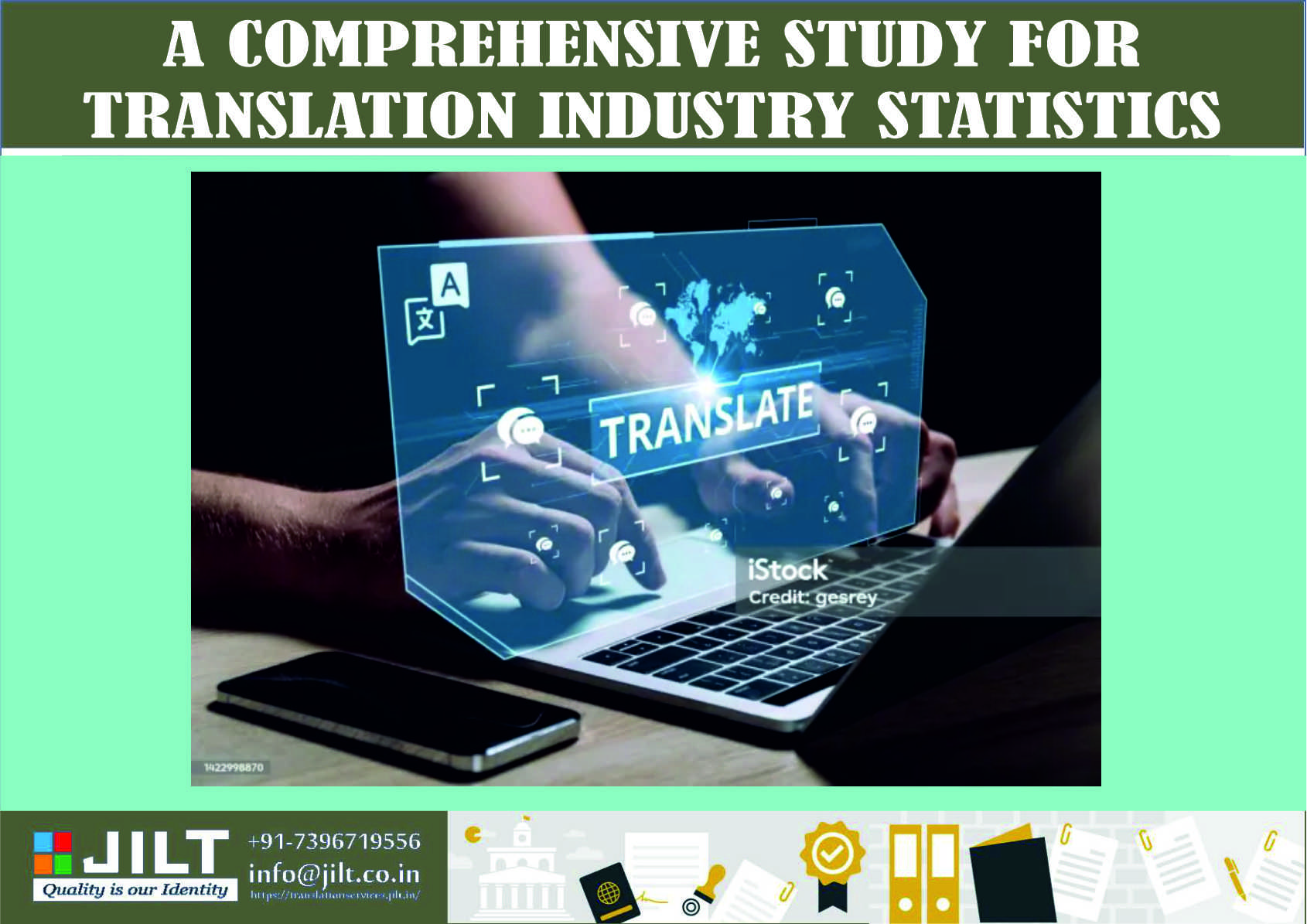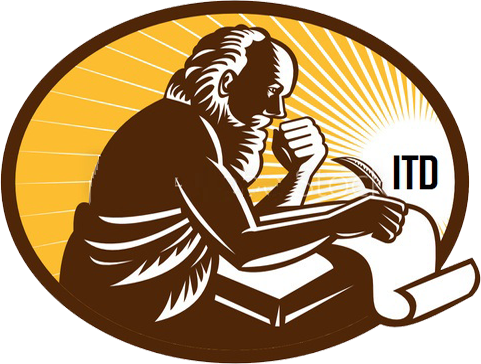
A COMPREHENSIVE STUDY FOR TRANSLATION INDUSTRY STATISTICS
by Dr. Abu Mazhar Khalid Siddique - January 17, 2024
In an increasingly interconnected world, defined by the seamless flow of information across borders and the intricate interplay of diverse communication channels, the translation industry emerges as a linchpin in the facilitation of global dialogue. Beyond merely bridging language gaps, this dynamic sector stands as a vital catalyst in breaking down linguistic barriers that might impede the smooth exchange of ideas, knowledge, and commerce.
The profound impact of the translation industry extends far beyond its role as a linguistic mediator, reaching into the very foundations of the global economy. As businesses, governments, and individuals engage in cross-cultural interactions on an unprecedented scale, the demand for effective translation services has soared. This surge is not merely a consequence of linguistic diversity but is emblematic of a world where collaboration and understanding transcend geographical boundaries.
In this comprehensive exploration, we embark on a journey into the heart of the translation industry, seeking to unravel its multifaceted dimensions. Through a meticulous examination of the latest statistics, we aim to paint a vivid picture of the industry's growth trajectory, identifying key trends that shape its current landscape. Beyond the numbers, we delve into the challenges that confront this sector, recognizing them as integral facets of an ever-evolving global communication landscape.
Moreover, our exploration extends to the far-reaching impact of the translation industry across various sectors. From healthcare and legal realms to marketing and technology, the influence of accurate and culturally sensitive translation resonates profoundly. This article, crafted with the expertise of industry insiders, not only illuminates the quantitative aspects but also provides qualitative insights, offering a holistic understanding of an industry that functions as the backbone of global communication. Join us in this deep dive into translation industry statistics, where numbers converge with narratives, and trends converge with the nuanced realities of an ever-connected world.
The Global Translation Market Overview
In recent years, the translation industry has undergone a transformative surge, propelled by the relentless forces of globalization, escalating international trade, and the rapid evolution of technology. This amalgamation of dynamic factors has not only shaped the industry's landscape but has positioned it as an indispensable player in facilitating global communication across linguistic boundaries.
As a testament to its remarkable trajectory, the Common Sense Advisory reports a compelling milestone: the global market for language services and technology soared to an impressive $49.60 billion in 2020. This figure is not merely a statistical reflection but a resounding echo of the escalating demand for translation services in a world where cross-cultural communication has become the lifeblood of international interactions.
The growth observed in the translation industry is intricately interwoven with the expanding scope of globalization. As businesses transcend geographical constraints to establish international footprints, the need for precise and culturally nuanced translation services becomes paramount. The industry's responsiveness to this demand is mirrored in its robust financial figures, showcasing its adaptability to the intricate demands of a globalized economy.
Moreover, the surge in international trade has further fueled the momentum of the translation industry. As enterprises navigate complex market landscapes and engage with diverse audiences, the role of translation services in ensuring accurate and contextually relevant communication becomes non-negotiable. The $49.60 billion benchmark is, therefore, not just a numerical reflection but a testament to the translation industry's pivotal role in lubricating the wheels of global commerce.
Technological advancements also emerge as a cornerstone of the industry's growth. The integration of cutting-edge language technology solutions has not only streamlined translation processes but has also enhanced the quality and efficiency of language services. This symbiotic relationship between technology and translation underscores the industry's commitment to staying at the forefront of innovation, meeting the evolving needs of clients in an increasingly digital world.
Market Segmentation and Key Players:
A nuanced examination of the translation market unveils a multifaceted landscape, intricately divided into distinct segments tailored to meet specific communication needs. The industry's expansive scope encompasses a spectrum of services, ranging from traditional translation and localization to interpretation and cutting-edge language technology solutions. Amidst this diversity, key industry players emerge as stalwarts, steering the course of the market's trajectory. Renowned language service providers (LSPs) such as Lionbridge, SDL, TransPerfect, and Welocalize stand as pillars in this dynamic arena, their collective expertise not only defining industry standards but also significantly contributing to the robust revenue streams that underscore the market's vitality.
Technological Integration in Translation:
Within the translation industry, technology has undeniably emerged as a transformative force, reshaping conventional paradigms. Machine Translation (MT) and Artificial Intelligence (AI) stand as pivotal agents of this evolution, fundamentally altering the landscape of content translation. The integration of advanced neural machine translation has ushered in a new era, marked by heightened accuracy and efficiency in linguistic transformations. This symbiosis of technology and translation not only accelerates the pace of language services but also heralds a paradigm shift in how industries approach multilingual communication, underscoring the indispensable role of technological advancements in ensuring precision and efficacy within the realm of translation.
Employment and Workforce:
The translation industry stands as a vibrant ecosystem, boasting a diverse and expansive workforce that plays a pivotal role in its functionality. Within this dynamic workforce, individuals assume specialized roles as translators, interpreters, project managers, and language experts. This collective proficiency serves as the backbone of an industry propelled by the demand for linguistic precision and cultural acumen. The surge in demand for language professionals underscores the industry's indispensable contribution to effective cross-border communication. As globalization intensifies, the translation workforce remains an essential nexus, ensuring seamless and nuanced language solutions.
Challenges Facing the Translation Industry:
In the midst of its impressive growth trajectory, the translation industry encounters formidable challenges that necessitate strategic navigation. Foremost among these challenges is the imperative for consistently delivering high-quality, culturally sensitive translations. This demand is particularly acute in sectors such as marketing, legal, and healthcare, where precision in linguistic and cultural nuances is paramount. Simultaneously, the industry grapples with the relentless pressure to stay abreast of rapid technological advancements and adapt to evolving client expectations. Balancing these intricate elements becomes crucial to sustaining the industry's excellence, requiring a delicate fusion of linguistic expertise, cultural insight, and cutting-edge technological integration.
Impact of COVID-19 on the Translation Industry:
The pervasive influence of the COVID-19 pandemic has reverberated across diverse industries, casting a significant shadow on the translation sector. Notably, the landscape of translation services underwent a seismic shift, witnessing a surge in demand for specific segments, such as medical and pharmaceutical translations, driven by the global urgency for health-related content. Conversely, industries reliant on travel and tourism experienced a decline in translation needs. Remote work and the widespread adoption of virtual collaboration tools emerged as the new paradigm, compelling the translation industry to swiftly recalibrate its operational strategies, reinforcing the sector's resilience and adaptability in the face of unprecedented challenges.
Regional Trends in Translation:
The translation landscape is intricately shaped by regional dynamics, where distinct factors such as economic development, cultural diversity, and international trade relations wield considerable influence. Europe, boasting a richly multilingual environment, stands as a pivotal hub for translation services, reflecting the continent's nuanced linguistic demands. Meanwhile, the Asia-Pacific region, fueled by robust economic growth and the forces of globalization, experiences a discernible upswing in the demand for language solutions. For businesses aspiring to broaden their global footprint, comprehending and navigating these regional trends is paramount. It involves not merely linguistic proficiency but a strategic understanding of the diverse cultural and economic tapestries that define effective cross-border communication.
Future Outlook and Emerging Trends:
The translation industry stands at the threshold of a dynamic future, propelled by an amalgamation of transformative forces. Globalization, serving as a perpetual engine, ensures the continued expansion of the industry, as businesses and individuals increasingly engage in cross-border interactions. The ongoing digital transformation further accelerates this trajectory, with technology emerging as the linchpin for future growth.
As we gaze into the crystal ball of translation services, the persistent need for cross-cultural communication looms large, steering the industry towards a future where linguistic diversity is not a barrier but an opportunity. The advancing frontier of technology, marked by the integration of Artificial Intelligence (AI), machine learning, and automation, will redefine the translation landscape. This evolution promises enhanced efficiency, accuracy, and adaptability, positioning the industry to meet the evolving demands of a rapidly changing global environment.
Moreover, the emergence of new language pairs amplifies the industry's scope, reflecting the diverse linguistic interactions in our interconnected world. The evolution of industry standards is not merely a reflection of change but a proactive response to the intricate challenges posed by globalization and technological innovation. Industry players must anticipate and embrace these shifts, adopting a forward-looking approach to remain at the forefront of delivering language solutions that resonate with the needs of an ever-evolving global clientele.
In essence, the future of the translation industry is a synthesis of technology, adaptability, and linguistic acumen. Those at the vanguard of this sector must navigate the intricate dance between tradition and innovation, capitalizing on emerging trends to craft a future where effective cross-cultural communication is not just a necessity but a seamless and enriching experience.
In final words our deep dive into translation industry statistics has illuminated the pivotal role this dynamic sector plays in our globalized world. From the robust growth propelled by globalization to the transformative impact of technological integration, the industry stands as a linchpin in facilitating effective cross-cultural communication. Despite facing challenges, the translation landscape remains resilient and adaptable. Looking ahead, the convergence of globalization, technological advancements, and evolving linguistic demands positions the industry for continued expansion. It beckons professionals to navigate the ever-changing currents with linguistic precision, cultural finesse, and a commitment to harnessing emerging trends, ensuring the translation industry's enduring relevance and influence.
Our organization employs native-speaking translators who can provide certified translation services in any language. We provide translation services in English (Urdu), Arabic (Spanish), German (French), Persian (Iranian), French (Italian), Japanese (Korean), Russian, and any other Indian or local language. Expert proofreaders at our company will inspect the translation. We also provide a courier service to deliver completed documents to our clients.
- Also Read :- PROCEDURES AND DOCUMENTS REQUIRED TO OBTAIN US VISA.
- Also Read :- Business Documents Translation Services
- Also Read :- Technical Documents Translation Services
- Also Read :- LISTED BELOW ARE TEN OF THE MANY APPLICATIONS OF MACHINE LEARNING IN THE FINANCIAL SECTOR.
- Also Read :- The importance and uses of undergraduate certificates translation.
- Also Read :- Inspection Certificate Translation Service
- Also Read :- THE VITAL ROLE OF BIRTH CERTIFICATES: TRANSLATION FROM TAMIL TO GERMAN
- Also Read :- Migration Certificate Translation Services
- Also Read :- The Importance of Translating Old Revenue Collection Receipts from Urdu to English
- Also Read :- Family register (booklet) translations (JILT - Certified Translation Services)
Search
Categories
Archives by Month
Popular Blog
QUICK TRANSLATION QUOTE
Need help with a translation?
Get in touch with us
Whether you have a specific project you want to discuss, need a translation quote or simply want to discuss your requirements, do not hesitate to get in touch with us.











Social Networks